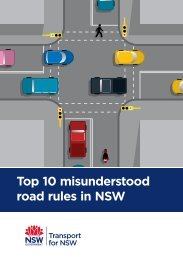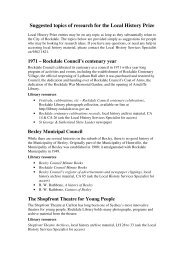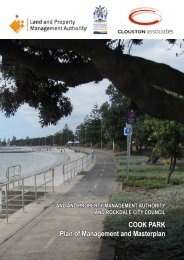The Kingsgrove Slasher - Rockdale City Council
The Kingsgrove Slasher - Rockdale City Council
The Kingsgrove Slasher - Rockdale City Council
Create successful ePaper yourself
Turn your PDF publications into a flip-book with our unique Google optimized e-Paper software.
<strong>The</strong> first spate of attacks (mid-late 1956) was centred on the Beverly Hills and <strong>Kingsgrove</strong> areas (thearea today which is largely dominated by the M5 expressway). This cluster of attacks can be seen inthe following diagram which the author has used to show just how localised the attacks were, aswell as how they were undertaken in such a short timeframe. Each attack has been numbered inchronological order, along with the address, victim’s name and the charge that Scanlon was foundguilty of (note: special reference has been made on this map to the site of the tennis club Scanlonplayed at – the significance of this site will be explained further in the "Dr Jekyll and Mr Hyde"section of this report):Figure 1: Clustered 1956 attacks (Beverly Hills & <strong>Kingsgrove</strong>)After these first eight localised attacks, the <strong>Slasher</strong> shifted his focus slightly and moved his attackscloser to where he resided at the time, Arncliffe. He perpetrated one attack in Undercliffe, but then,a few weeks later, travelled to the North Shore’s Lavender Bay and attacked a teenager there. Thiswas then followed only a week later by an attack at Turella. <strong>The</strong>se remaining 1956 attacks are shown5
It can be seen through Figure 1, Figure 2 and Figure 3 that there were no known attacks by the<strong>Slasher</strong> during 1957. His whereabouts during this year have been widely speculated upon, and some,like the then Superintendent M.F. Calman, even suggested that the <strong>Slasher</strong> may have been in amental institution during this time (‘Day and Night Hunt for <strong>Slasher</strong>’ 1959).<strong>The</strong> <strong>Slasher</strong>’s 1958 attacks began in Greenwich (refer Figure 3 – attack number 12). From there, the<strong>Slasher</strong> moved back closer to his place of residence, and attacked Mrs. Marguerite Austin, a mucholder woman in Turella (refer Figure 2 – attack 13). After this, there was only one more attack the<strong>Slasher</strong> was convicted of in 1958, and for this he had travelled to Kyeemagh (refer Figure 4):Figure 4: Isolated Kyeemagh attack (1958)<strong>The</strong> <strong>Slasher</strong>’s 1959 attacks began early in the year, with the first two attacks taking place in January(refer Figure 2 – attacks 15 and 16). Shortly after, there were two attacks in February, for which the<strong>Slasher</strong> had moved closer to the Earlwood/Bardwell Park region. <strong>The</strong>se attacks were the <strong>Slasher</strong>’sfinal and ended a reign of terror which Sydneysiders preferred to forget about (refer Figure 5 below– attacks 17 and 18):7
Figure 5: Bardwell Park/Earlwood attacks (1959)A Window into CrimeWhat horrible perpetrations was Scanlon actually inflicting on his victims? In each instance, Scanlonwould break into his randomly chosen house through a window, before creeping into the femaleoccupant’s room (victims ranged in age from 7 – 72, and were often attacked whilst they slept nextto their husbands or close to their fathers). Scanlon would proceed to slash the clothing of thewomen and girls, with sharp instruments such as knives or razors and then, ‘vanishing as silently ashe had arrived’, would escape quickly (Madden 2011). Whilst reports vary of exactly the nature ofScanlon’s crimes, the consistent themes are that the attacks were always in the ‘darkness of night’(Hill and Madden 2004, p.157) and that attacks were always made in bedrooms whilst victims weresleeping.Some of the <strong>Slasher</strong>’s early crimes were reported in reasonable detail by the papers of the time. Forexample, one Melbourne newspaper reported in some detail the attack on Miss. Lorraine Cousins ofArncliffe on the night of the 20 th December, 1956. On this night, the <strong>Slasher</strong> had crept into thehousehold, and snuck into the teenager’s room. <strong>The</strong> family (including the victim) had no idea the<strong>Slasher</strong> had been in their house until they woke in the morning to find Lorraine’s petticoat slip with‘half a dozen slashes down the front’ neatly tucked under a blanket at the foot of her bed, as well asa slashed bikini top draped over the bed head (‘<strong>The</strong> slasher’s on the prowl again’ 1956). Incredibly,Miss. Cousins had managed to sleep through the whole ordeal!8
Although most of the <strong>Slasher</strong>’s attacks were relatively harmless and involved slashing items ratherthan people, it must not be forgotten that some of Scanlon’s crimes did eventually became moresinister. According to one Dr. Listwan who was a psychiatrist giving evidence at Scanlon’s trial, onthree occasions Scanlon ‘“caused bodily harm to his victims”’ (‘<strong>Kingsgrove</strong> <strong>Slasher</strong> Pleads Guilty;Master Mind <strong>The</strong>ory’ 1959). <strong>The</strong>se physical attacks included cuts, scratches or bruises around thechest area (Hill and Madden 2004). Interestingly, Dr. Listwan also hastens to add that the instancesof Scanlon causing physical harm to his victims were only ‘“due to the fact he was panicked”’. Dr.Listwan is implying that Scanlon’s intention was not to harm the women and that this was simply anunfortunate by-product of Scanlon feeling as if he was going to be caught (‘<strong>Kingsgrove</strong> <strong>Slasher</strong> PleadsGuilty; Master Mind <strong>The</strong>ory’ 1959). Time and again, sources point to Scanlon’s motives coming fromthe thrill of being caught rather than any intention to harm the women and girls.However, the extent to which Scanlon physically harmed his victims as opposed to terrorising themvaries depending on which source is consulted. In personal communications between the author ofthis report and one local resident of the time, Mr. Graham Davis (son of the then Officer in Charge of<strong>Kingsgrove</strong> police, Constable Ed Davis), he revealed a slightly different memory of the events to Dr.Listwan. David stated that the <strong>Slasher</strong> ‘never injured any woman’ and that although a woman inBexley ‘claimed she had been attacked and showed police marks on her chest’, it was later revealedthat she had self-inflicted these wounds in an effort to seek revenge on her boyfriend of the time(Davis 2012, pers. comm., 19 April).Whether the physical abuse was intended by the <strong>Slasher</strong> or not, one example of it was reported in aMelbourne newspaper in dramatic fashion. <strong>The</strong> by-line of the article read that the <strong>Slasher</strong> had‘brutally battered a pretty teenager about the head with a heavy block of wood’ (‘Sydney “<strong>Slasher</strong>”Batters Young Girl’ 1956). This attack, on Undercliffe teenager Miss. Rosalie Meyer, took place onthe 26 th November 1956, and it did much to spread fear through Sydney (and indeed Australia). <strong>The</strong>article remarked that Meyer had ‘screamed in terror and pain as blood poured from a deep woundon her forehead’. Imagine the fear gripping the nation as residents read such stories as thefollowing:9
This correlates with anecdotal evidence from emails received from Graham Davis, who tells of theextensive media coverage of the <strong>Kingsgrove</strong> <strong>Slasher</strong> events; namely how the media reported ‘howthe police car attached to <strong>Kingsgrove</strong> didn’t have a radio’ (Davis 2012, pers. comm., 19 April). <strong>The</strong>very next day after this media expose, a replacement car with a radio was despatched to <strong>Kingsgrove</strong>,so somewhat amusingly, the <strong>Slasher</strong> was not all bad news for the area! In fact, some localbusinessmen were elated by the goings-on – they were pleased by the national attention beingdrawn to <strong>Kingsgrove</strong> and the additional trade that went along with that (Hill and Madden 2004). Thisview was not shared by all – the President of the <strong>Kingsgrove</strong> Chamber of Commerce, Mr. R. Young,had pushed to have the word ‘<strong>Kingsgrove</strong>’ removed from all references to the <strong>Slasher</strong>! (‘MentalHarm’ 1959)Criticism against the police was certainly rampant during the reign of the <strong>Kingsgrove</strong> <strong>Slasher</strong>, aspressure was increasingly mounted on the constabulary to apprehend the perpetrator and to do soquickly (Kidd 2005). One newspaper report from the day was unrelenting in its attack on the policethat were working on the <strong>Slasher</strong> case, describing their ‘futile efforts’, and leading with the frontpageheadline of ‘An Appalling Record by the Police’ (‘Yes, the <strong>Slasher</strong> struck again last night’ 1959).<strong>The</strong> paper called for a ‘new, more imaginative approach’ in order to capture the <strong>Slasher</strong>, yet it failedto recognise the hopeless under-resourcing the local police endured.<strong>The</strong> paper also failed to recognise the immense efforts that the police were actually expending insolving this case – ‘Detective Sergeant Brian Doyle and other detectives from the CriminalInvestigation Branch were working around the clock to try to uncover his identity’ (Hurstville <strong>City</strong>Library, Museum and Gallery Collection 2005). Another source tells of the ‘scores’ of plainclothesand disguised police patrolling the St. George area day and night, as well as the fact that police instations were constantly manning the phones and taking down messages of reported sightings(‘Police in Disguise: Wide hunt for the “slasher”’ 1959). Moreover, the NSW Police Commissioner atthe time, Mr. C.J. Delaney, was working hard in conjunction with all Australian and New ZealandPolice Commissioners to obtain any information about known criminals who might fit the <strong>Slasher</strong> bill(‘Clue to “<strong>Slasher</strong>” in Prints’ 1958).Politicians fought back against the criticism; with the Premier at the time, Mr. Cahill, assuringparliament that extra men and cars had been dispatched to the case, and proudly boasting that eight15
though – claiming that ‘the slasher had fled from hundreds of suburban bedrooms’ – perhaps anexaggeration on the 20-25 known attacks!<strong>The</strong> Locals Fight BackLocals reacted accordingly to the media frenzy, and began to take such actions as restricting theirdaughters’ evening outings and locking their doors and windows as a matter of course (Hill andMadden 2004). <strong>The</strong> <strong>Slasher</strong> was starting to have a real impact on the residents’ daily lives, and theywere fed up. One <strong>Kingsgrove</strong> teenager at the time, Miss. Gloria Ward, told the newspapers that herparents were so worried about her safety that they made her catch a taxi home from the trainstation after attending her night classes at Technical College (‘Mental Harm’ 1959). Such securitymeasures would have been unheard of in the previously sleepy late-1950s Sydney.What Sydney (and in particular, the St. George area) was having a hard time overcoming, was themental and psychological strain the <strong>Slasher</strong> was placing on them. At the time, <strong>Rockdale</strong> AldermanR.K. Hislop pointed out that the <strong>Slasher</strong> had inflicted very little physical damage yet had ‘“done aterrific lot of mental harm in this district”’ (‘Mental Harm’ 1959). As a result, locals were genuinelystarting to feel stressed, worried, and frustrated that they could not go about their everyday lives asthey once had. One special investigation by the Sydney Morning Herald described the ‘strange,artificial lives now being led by the residents of Sydney’s southern suburbs’. <strong>The</strong> article pointed tothe fact that residents were taking abnormal precautions such as staying at home every night andpurchasing guard-dogs to protect their property. Furthermore, milkmen completing their pre-dawnrounds were deliberately rattling their bottles so as not to be mistaken for an intruder, and youngmen were avoiding wearing tennis outfits – the favoured apparel of the <strong>Slasher</strong> (‘Under the Spell ofthe “<strong>Slasher</strong>”: New hope in the blighted suburbs’ 1959).Locals soon began to take the law into their own hands, with some residents ‘sleeping with rifles,iron bars, fire extinguishers and bags of flour and pepper for protection’ (Hurstville <strong>City</strong> Library,Museum and Gallery Collection 2005). A long-term resident of the <strong>Kingsgrove</strong> area, Mrs. ChristineDryden, concurs with such reports, stating in personal communications with the author of this reportthat ‘“I can remember Dad having a cricket bat in Mum and Dad’s bedroom”’ (Dryden 2012, pers.comm., 26 April). Another similar example was of one female resident of the time who had a fire17
women and girls. One newspaper at the time, the Daily Mirror, predicted, before the identity of the<strong>Slasher</strong> was known, that the perpetrator would be the ‘possessor of a pathological hatred of allwomen’ (‘Yes, the <strong>Slasher</strong> struck again last night’ 1959). This is unlikely to be entirely true given thedeep impact Scanlon’s mother’s death had on him, plus his seemingly loving relationship with hiswife. More likely as the key motive to his crimes was simply the desire for excitement, thrills andchases.Some experts have argued that Scanlon was motivated to attack women and girls for his own sexualgratification. Psychiatrists at the time of his trial described Scanlon’s attacks as ‘“compulsions of thesadistic and masochistic variety”’ and the Defence Counsel at the trial called his own client a ‘“sexpervertedpsycho-neurotic”’ (Hill and Madden 2004, p.159). Scanlon himself denied any linkbetween his attacks and sexual satisfaction, claiming that his attacks were mostly motivated by thethrill of the chase. One questions how much of the potentially sexual nature of these crimes werehidden from the public, owing simply to the taboos of the time. St. George resident, ChristineDryden, who was a child at the time of the attacks, recalls her parents shielding her from the fulltruth –‘“…there was a sense of disquiet because we were never told exactly what the <strong>Slasher</strong>did…did he slash and disfigure? Did he slash through fly screens? Rape and sexual assaultwere not openly discussed…but we all knew that the man was posing a real threat.”’(Dryden 2012, pers. comm., 26 April)Evidence given by psychiatrists at Scanlon’s trial also point to Scanlon having mental disordersranging from an ‘obsessive compulsive character defect’ to a ‘thought disorder consistent with mildschizophrenic thinking’ (‘<strong>Kingsgrove</strong> <strong>Slasher</strong> Pleads Guilty; Master Mind <strong>The</strong>ory’ 1959). It is difficultto say to what extent these alleged mental disorders caused Scanlon to attack, especially given therelative immaturity of the psychology field at the time and its early diagnostic tools. Anecdotalevidence from one <strong>Rockdale</strong> victim, Mr. Noel McKinnon, suggests the possible insanity of Scanlonwho had bared his teeth and growled like a dog during the attack:‘“<strong>The</strong> man is obviously a maniac…He made guttural noises but did not speak. I could see hisbared teeth. He then growled like a wild animal. It was an eerie experience.”’(Noel McKinnon, as quoted in ‘Cornered Man “Snarls” at Householder’ 1958)21
Catching an Athlete‘“I am your man, I am the <strong>Kingsgrove</strong> <strong>Slasher</strong>” – those few words ended one of the country’slongest and most extraordinary manhunts.’(Bouda 1991, no page numbers)It was famously the uttering of these few words that put an end to Sydney’s fear and terror. In amatter of only a few words of confession, the athlete had finally been caught.On the night that Scanlon was caught (April 30 th 1959), he had already terrorised two Earlwoodresidents in separate attacks. This time, though, Scanlon was not so lucky. In both instances, theladies had woken up before Scanlon had a chance to begin the slashing, and in both cases, Scanlonwas forced to flee the scene as quickly as he could. On his second attempt to get away, Scanlon‘virtually ran into the arms of arresting officers at the foot of Nannygoat Hill, near Turella RailwayStation’ and the chase for Sydney’s terroriser was officially over (Bouda 1991, no page numbers).Clearly, by this stage of the <strong>Slasher</strong>’s reign, police resourcing must have improved, as nearly 100police converged on the area within minutes of Scanlon’s capture (Hill and Madden 2004). Somemore recent newspaper articles have embellished the capture story, claiming that Scanlondramatically dived into a swamp at Turella prior to his capture (‘History on this Day’ 2012) This is anunlikely story given how forthcoming his confession was.Figure 10: Nannygoat Hill, Turella as it looks in 2012 (author's own photographs)22
A few key clues had led to the capture of the <strong>Slasher</strong> – by December 1958 police had built up enoughof a profile of the <strong>Slasher</strong> to narrow the hunt significantly. <strong>The</strong>y had found fingerprints on the scalpelthe <strong>Slasher</strong> had used in the Kyeemagh attack, and had also narrowed the profile to someone whousually wore athletic/tennis gear such as white shorts, white shirts and sandshoes (Hurstville <strong>City</strong>Library, Museum and Gallery Collection 2005).Some fascinating first-hand recollections of the police hunt were provided to the author by GrahamDavis, son of Ed Davis, Officer in Charge of the <strong>Kingsgrove</strong> Police at the time. Graham recalls how in1957, as a young second-year journalism cadet, he watched with amazement as many a night hisfather would don 'civvies' and ‘at 11pm put our private car…in the driveway of a home in MorganStreet [<strong>Kingsgrove</strong>]…a driveway with a view to the right and left…and hope Scanlon would be seen’(Davis 2012, pers. comm., 19 April). Graham also remembers how ‘Dad would arrive home at dawnto a very relieved Mrs. Davis’ (ibid). <strong>The</strong>re is no doubt that the personal efforts of these dedicatedpolicemen were taking a toll on their families too.Another interesting insight on Scanlon’s capture comes from “John” – Scanlon’s former social tennispartner (“John” 2012, pers. comm., 26 April). “John” told about one Sunday morning in early 1959when Scanlon did not turn up for tennis. Being worried about him, one of the men from the tennisgroup telephoned Scanlon’s wife to enquire as to his whereabouts. You can imagine the shockwavesthat were felt not only in that tennis club but also the community of <strong>Kingsgrove</strong> when Scanlon’s wifehad to reveal to them that it was he who had been the <strong>Slasher</strong> all along! To say that “John”remembers feeling dumbstruck is an understatement indeed.After the capture of Scanlon, much recognition was finally enjoyed by Detective-Sergeant BrianDoyle of the <strong>Kingsgrove</strong> Police, whom had led the search efforts. Doyle has been posthumouslydescribed as an ‘honest cop, the no-nonsense tough guy who succumbed to no pressure’ (Brown2002). According to long-term resident, Christine Dryden, Doyle was ‘lauded as a hero for manyyears after the event’ (Dryden 2012, pers. comm., 26 April). Indeed, for his efforts in capturing the<strong>Slasher</strong>, Doyle was awarded the Peter Mitchell Trophy in 1959 for outstanding police work (Brown2002).23
Doyle went on to lead a very distinguished career in the Police Force and he even rose to the rank ofAssistant Commissioner of the NSW Police (Hill and Madden 2004). <strong>The</strong> <strong>Kingsgrove</strong> <strong>Slasher</strong> case waslong held up as an example of policing at its finest (despite the initial attacks on the police at thetime) – for example, the 1961 Royal Show even had a special Police exhibition proudly showcasingthe ‘long and eventually successful hunt for the “<strong>Kingsgrove</strong> <strong>Slasher</strong>”’ (‘Light on crime’ 1961).Figure 11: Detective-Sergeant Brian Doyle of the <strong>Kingsgrove</strong> Police (source: ‘Liked Chase, Police Say’ 1959)Trial of a <strong>Slasher</strong>Scanlon first faced court the day after his capture; with a packed local Kogarah Court the scene of hisinitial hearing. This hearing, indeed like the entire case, fascinated both media and residents alike, asthis newspaper article captures:‘Pressmen and local residents crowded around Kogarah police station from 8 a.m., waitingfor a chance to see Scanlon. Schoolchildren and office-workers joined the crowd at lunchtime.’(‘Police Name Man in Court as “<strong>Kingsgrove</strong> <strong>Slasher</strong>”’ 1959)<strong>The</strong> full case was then heard in September 1959 at the Central Criminal Court of Sydney – acourtroom that was supposedly packed with interested women and girls. In the innocent era of thelate 1950s, at one point in the trial, all women (including the stenographer) were removed from thecourtroom owing to the 'delicate nature' of some police evidence (Hill and Madden 2004, p.159). No24
doubt this case would have caused shock and scandal to the public of Sydney if the full details hadbeen revealed!In much the same manner and characteristics Scanlon held in his general life (quiet; unassuming;meek), at his full trial he simply ‘sat relaxed in the dock with his hands folded’ and uttered only oneword – “Guilty” – which he pleaded for the eighteen offences he was charged with (‘<strong>Kingsgrove</strong><strong>Slasher</strong> Pleads Guilty; Master Mind <strong>The</strong>ory’ 1959). He was true to his outwardly calm, unsuspecting(and some may say, boring) nature to the end. At the trial, a spotlight was shone on Scanlon’s Jekylland Hyde character when this outward appearance was juxtaposed with evidence from some of thevictims – one female claimed she ‘“woke in darkness feeling blows to the head and hearing a mangrowling like a dog”’ (Hurstville <strong>City</strong> Library, Museum and Gallery Collection 2005). Once again, thepublic were left scratching their heads as to how someone so unassuming could turn into such acold-blooded animal. Incredibly, though, when Scanlon was sentenced to a total of 104 years to beserved concurrently in jail (final term set at 18 years), many people, including some of his victims,were outraged because they felt his sentence was too severe! (Bouda 1991)In 1960, Scanlon appealed against Justice Macfarlan’s findings at the Court of Criminal Appeal.However, Chief Justice Evatt dismissed the appeal, emphatically stating that ‘“<strong>The</strong> recurrence ofcrimes of this type must be prevented with the full vigour and justice of the law”’ (Sydney MorningHerald, as quoted in Bouda 1991, no page numbers). At a time when mental illness was rarelyrecognised and certainly was taboo, courts preferred to ‘lock up’ rather than treat and rehabilitate(Hill and Madden 2004). This was despite a strong push by Scanlon’s Q.C. at the original trial toencourage rehabilitation, psychiatric treatment and the request to serve the last half of his sentenceon a prison farm rather than jail (‘Q.C. Urges “<strong>Slasher</strong>” be Given Chance to Rehabilitate Himself’1959).Life on the InsideOne source of information about Scanlon’s time ‘on the inside’ is Cheryl Jorgensen’s thesis titled <strong>The</strong>Taint, in which she retells the memoirs of one of Scanlon’s fellow Goulbourn Gaol inmates, Ray“Poss” Ide. In the book, Ide talks much about his time competing in prison athletic games againstScanlon – and fondly recalls one of the only times he was able to beat Scanlon in a running race, In25
Ide's own words, '“I enjoyed beatin’ the bloke they called <strong>The</strong> <strong>Kingsgrove</strong> <strong>Slasher</strong>…”' (Jorgensen2008, p.104). <strong>The</strong> friendly rivalry meant that Ide and Scanlon '“finished up pretty good pals”' in Ide’sown words.Apart from Scanlon’s athletic abilities in jail, little else is known of how he spent his time, norwhether his ‘rehabilitation’ was successful. As a modern reader looking back at some of the originalsources, it is hard to believe that psychiatrists at the time like Dr. Listwan recommended to the courtthat Scanlon’s ‘rehabilitation’ be undertaken in three parts – psycho-therapy, hormonal treatment‘“causing temporary sterilisation”’ and, failing those two treatments working, an operation on hisbrain to ‘“ease the obsessive compulsive states”’ (‘<strong>Kingsgrove</strong> <strong>Slasher</strong> Pleads Guilty; Master Mind<strong>The</strong>ory’ 1959). It’s hard to imagine such radical ‘treatments’ forming any part of a modern-dayrehabilitation program!In personal communications with Scanlon's tennis partner “John", he recalls that during the prisontime, one of the “tennis boys” went to visit him in jail. “John” recalls that during this visit, the manquestioned Scanlon of his motives, to which Scanlon was still adamant that his only motive was thethrill or buzz of the chase. Specifically, Scanlon admitted to gaining a thrill from waking the victims’sleeping husbands and getting away just in the nick of time (“John” 2012, pers. comm., 26 April). Infact, at the time of his capture, Scanlon was quoted as saying '"I got a bigger thrill out of that[husbands chasing after him] than having the police chase me”’ (Scanlon, as quoted by Det.-Sgt.Doyle in ‘Girl’s Pyjamas Cut’ 1959).<strong>The</strong> <strong>Slasher</strong> Today: Where Is He Now?Not much is known about Scanlon’s life after being released from prison, and in fact, it is unclearwhether he is even still alive today. Even the length of time he actually served in jail varies acrosssources (anywhere from ten to eighteen years) (‘History on this Day’ 2012; Hurstville <strong>City</strong> Library,Museum and Gallery Collection 2005; “John” 2012, pers. comm., 26 April). All that is known is thatafter serving his jail time as a ‘model prisoner’ (‘History on this Day’ 2012), he then disappeared intoobscurity never to be heard of again (Bouda 1991). In the words of Scanlon’s one-time ‘friend’,“John”, once Scanlon was free, “<strong>Kingsgrove</strong> wouldn’t have him” and he was forced to “go bush toDubbo” (“John” 2012, pers. comm., 26 April).26
What is interesting is that somewhere in the vicinity of 2004, newspaper recollections of the <strong>Slasher</strong>story began to refer to David Joseph Scammony rather than David Joseph Scanlon as he had hithertobeen referred to (‘Signposts; This Life’ 2004). This begs a few questions – at this point in time, didScanlon change his name by deed poll, or had he requested the newspapers to refer to himdifferently so that he could turn a new leaf and put the <strong>Slasher</strong> chapter of his life well and trulybehind him? In one of the recent newspaper articles, it is stated that after his time in jail,Scammony/Scanlon was given a new identity (‘On this Day’ 2008).No references to the <strong>Slasher</strong> by any other name were found by the author whilst completing thisresearch paper. In undertaking research for this report, the author also searched the AustralianElectoral Roll (AEC) for any mention of either David Joseph Scanlon or David Joseph Scammony,however neither were retrieved in the search. It is uncertain whether Scanlon/Scammony has sincepassed away (he would be approximately 82 years of age now) or whether he simply is no longerregistered on the AEC. Either way, the horror that this man inflicted upon Sydney in the late 1950swill certainly be remembered for a long time to come. Heavy iron bars remaining on the windows ofsome old <strong>Kingsgrove</strong> homes are just one of the reminders.27
Reference List‘100 Police Wait for “<strong>Slasher</strong>” to Strike’ 1958, <strong>The</strong> Age, 12 December, p.2‘Armed Wait for Attack by “<strong>Slasher</strong>”’ 1958, Sydney Morning Herald, 9 December, p.19‘Aussies End 4 Year Hunt, Seize <strong>Slasher</strong>’ 1959, Chicago Daily Tribune, 8 September, p.B11Bouda, S. 1991, Crimes that Shocked Australia, Bantam Books, Moorebank, SydneyBrown, M. 2002, ‘Nemesis of crims and corruption’, Sydney Morning Herald (Obituaries), 9 August,viewed 19 April 2012, Cassidy, J. 2000, ‘<strong>The</strong> hell-raiser; Profile’, Sydney Morning Herald, 9 December, p.80‘Clue to “<strong>Slasher</strong>” in Prints’ 1958, Sydney Morning Herald, 11 December, p.4‘Column 8’ 1958, Sydney Morning Herald, 10 December, p.1‘Cornered Man “Snarls” at Householder’ 1958, Sydney Morning Herald, 8 December, p.3Davis, G. 2012, personal communication, 19 April‘Day and Night Hunt for <strong>Slasher</strong>’ 1959, Sydney Morning Herald, 12 February, p.6Dryden, C. 2012, personal communication, 26 April‘Girl’s Pyjamas Cut’ 1959, Sydney Morning Herald, 17 June, p.4Hill, R. & Madden, B. 2004, <strong>Kingsgrove</strong>: <strong>The</strong> First Two Hundred Years, Canterbury & District HistoricalSociety, Campsie, Sydney‘History on this Day’ 2012, Daily Telegraph, 30 April, p.25Hurstville <strong>City</strong> Library, Museum and Gallery Collection, 2005 exhibition – “Crime Scene: 20 th Centurysnapshots on crime and punishment in St. George”“John” (real name withheld) 2012, personal communication, 26 AprilJorgensen, C. 2008, <strong>The</strong> Taint, Boolarong Press, Salisbury, QueenslandKidd, P.B. 2005, <strong>The</strong> Australian Crime File: A ‘Best Of’ Collection of Notorious True Crime Stories, <strong>The</strong>Five Mile Press, Rowville, Victoria‘<strong>Kingsgrove</strong> <strong>Slasher</strong> Pleads Guilty; Master Mind <strong>The</strong>ory’ 1959, Sydney Morning Herald, 8 September,p.4‘Light on crime’ 1961, <strong>The</strong> Australian Women’s Weekly, 29 March, p.7‘Liked Chase, Police Say’ 1959, Sydney Morning Herald, 17 June, p.4Madden, B. 2011, History of <strong>Kingsgrove</strong>, viewed 19 April 2012,‘Mental Harm’ 1959, Sydney Morning Herald, 1 March, p.3128
National Library of Australia (n.d.), David Joseph Scanlon – <strong>The</strong> <strong>Kingsgrove</strong> <strong>Slasher</strong>, viewed 5 June,‘On this Day’ 2008, Daily Telegraph, 30 April, p.77‘Police in Disguise: Wide hunt for the “slasher”’ 1959, Sydney Morning Herald, 15 February, p.3‘Police Name Clerk Wanted “<strong>Slasher</strong>”’ 1959, <strong>The</strong> Age, 2 May, p.3‘Police Name Man in Court as “<strong>Kingsgrove</strong> <strong>Slasher</strong>”’ 1959, Sydney Morning Herald, 2 May, p.4‘Public Responds to “<strong>Slasher</strong>” Appeal; New Plans by Police’ 1959, Sydney Morning Herald, 14February, p.4‘Q.C. Urges “<strong>Slasher</strong>” be Given Chance to Rehabilitate Himself’ 1959, Sydney Morning Herald, 12September, p.5Samuelson, S. & Mason, R. 2008, A History of Australian True Crime, Ebury Press, North Sydney‘Signposts; This Life’ 2004, Sydney Morning Herald, 30 April, p.26‘“<strong>Slasher</strong>” Scare; Man in Chase’ 1959, Sydney Morning Herald, 25 February, p.1‘Suspected <strong>Slasher</strong> Seen Twice More’ 1958, Sydney Morning Herald, 10 December, p.1‘Sydney “<strong>Slasher</strong>” Attacks Girl, 14’ 1956, <strong>The</strong> Argus, 15 December, p.9‘Sydney “<strong>Slasher</strong>” Batters Young Girl’ 1956, <strong>The</strong> Argus, 27 November, p.9‘<strong>The</strong> slasher’s on the prowl again’ 1956, <strong>The</strong> Argus, 20 December, p.3‘Under the Spell of the “<strong>Slasher</strong>”: New hope in the blighted suburbs’ 1959, Sydney Morning Herald, 1March, p.31‘Vigilantes Patrol Streets, Search for the “<strong>Slasher</strong>”’ 1958, Sydney Morning Herald, 13 December, p.1‘Weeping Girl Tells of Attack by “Growling Man”’ 1959, Sydney Morning Herald, 17 June, p.4‘Yes, the <strong>Slasher</strong> struck again last night. An appalling record by the police’ 1959, Daily Mirror, 13February, p.129
















